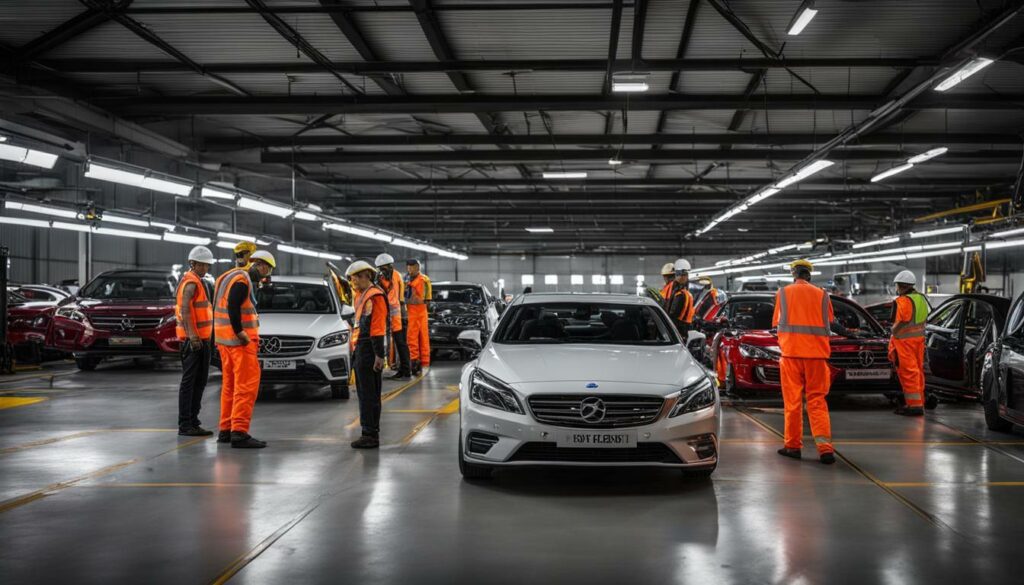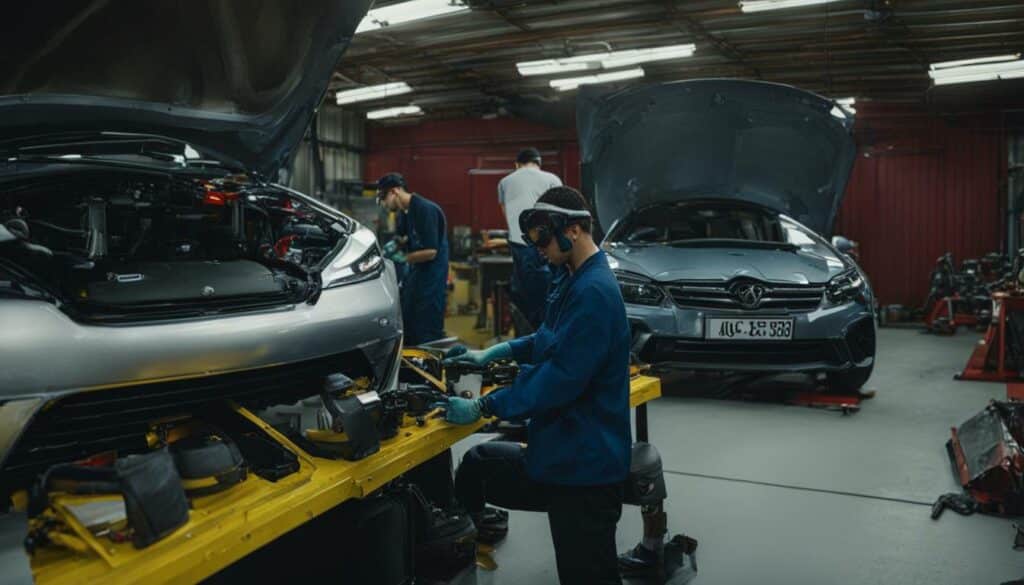Importing a car into New Zealand can be an exciting experience, but it can also be overwhelming if you’re not familiar with the regulations and requirements. Before you can register an imported car in New Zealand, you must ensure that it meets the country’s strict safety, emissions, and road compliance standards. Adapting an imported car to meet these standards requires careful planning and attention to detail.
In this how-to guide, I will provide you with all the information you need to successfully adapt an imported car to meet New Zealand standards. From understanding the importation regulations to modifying your car for safety and compliance, this guide will take you through each step of the process.
Key Takeaways:
- Importing a car into New Zealand requires compliance with strict safety, emissions, and road compliance regulations.
- Modifying an imported car to meet these standards requires thorough planning and attention to detail.
- Vehicle testing and certification are necessary before a car can be registered in New Zealand.
- Understanding the importation regulations and documentation requirements is crucial for a successful importation process.
- Registering an imported car in New Zealand involves vehicle identification, documentation, and registration fees.
Understanding New Zealand’s Vehicle Importation Regulations
If you’re thinking about importing a car to New Zealand, it’s essential to understand the country’s importation regulations. Compliance with NZ regulations is crucial to ensure your vehicle meets the country’s safety, environmental, and road compliance standards.
The first step in importing a vehicle to New Zealand is to determine if it’s eligible. To comply with car importation regulations, your car must meet certain criteria, including age, emissions, and safety standards. You should research these criteria and ensure your vehicle is eligible before importing it.
Once you have determined your car’s eligibility, the next step is to obtain customs clearance. This process involves providing documentation to the New Zealand Customs Service and paying the requisite import duties and taxes.
After obtaining customs clearance, you must modify your car to meet New Zealand’s safety and environmental standards. This process can involve several modifications, including upgrading lighting, adding seatbelts, and ensuring structural integrity.
Before driving your imported car on New Zealand roads, you must have it tested and certified. This process involves obtaining a Warrant of Fitness (WOF) and undergoing a vehicle inspection to ensure compliance with safety and environmental standards.
Finally, you must register your imported car in New Zealand. This process involves obtaining vehicle identification, providing required documentation, and paying registration fees.

Importing a car to New Zealand can be a complicated process. Compliance with NZ regulations is vital to ensure your vehicle meets the required safety and environmental standards. Understanding the regulations and requirements involved in car importation can save you time, money, and headache in the long run.
Modifying Cars to Meet New Zealand Safety Standards
Ensuring that an imported car meets New Zealand’s safety standards is crucial for registration and road safety. There are several modifications that may be necessary to comply with these standards.
Lighting: New Zealand requires that imported cars have left-hand drive headlights converted to right-hand drive. The headlights must also meet specific lighting requirements, including color temperature and beam patterns.
Emissions: Vehicles must meet specific emission standards as outlined by the New Zealand Transport Agency. Modifications to the exhaust system may be necessary to comply with these standards.
Seatbelts: All vehicles must have seatbelts that meet New Zealand’s safety standards, and these must be installed in all seating positions. The seatbelts must also be correctly anchored to the vehicle’s frame.
Structural integrity: The vehicle’s structural integrity must meet the safety standards set by the New Zealand Transport Agency. If the vehicle’s structure requires modification, it must be approved by a certified engineer.
It’s important to note that modifications must comply with New Zealand’s regulations and safety standards and cannot compromise the vehicle’s safety. Any modifications must be carried out by certified professionals and inspected and approved by the relevant regulatory bodies.

Before an imported vehicle can be registered in New Zealand, it must undergo a series of tests and obtain the necessary certifications to comply with the country’s regulations. The process of testing and certification is critical to ensuring the safety and compliance of imported vehicles on New Zealand’s roads.
The first step in the testing and certification process is obtaining a Warrant of Fitness (WOF). This certificate verifies that the vehicle meets New Zealand’s safety and emission standards. A WOF is required for all vehicles registered in New Zealand and must be renewed every six months or annually depending on the age of the vehicle.
In addition to the WOF, imported vehicles must also undergo a series of compliance tests to determine their roadworthiness. The compliance tests assess the vehicle’s safety features, emissions, and overall compliance with New Zealand’s regulations. Once the tests are completed, an engineer’s report is generated.
The engineer’s report is an essential document that verifies the modifications and compliance of the imported vehicle. It must be submitted to the New Zealand Transport Agency (NZTA) to obtain a Certificate of Compliance (CoC). The CoC is required for vehicle registration in New Zealand and confirms that the vehicle meets all of the country’s safety and emission standards.
It is essential to use an approved inspection agency to carry out compliance tests. These agencies have been authorized by the NZTA to conduct inspections and are well-versed in the regulations and requirements for importing and modifying vehicles. Using an approved inspection agency will ensure that the vehicle meets New Zealand’s standards and is eligible for registration.
| Testing and Certification Requirements | Description |
|---|---|
| Warrant of Fitness (WOF) | A certificate that verifies the vehicle meets New Zealand’s safety and emission standards. |
| Compliance Tests | Tests conducted by approved inspection agencies to assess the vehicle’s safety features, emissions, and compliance with New Zealand’s regulations. |
| Engineer’s Report | A document that verifies the modifications and compliance of the imported vehicle. |
| Certificate of Compliance (CoC) | A certificate required for vehicle registration in New Zealand that confirms the vehicle meets all of the country’s safety and emission standards. |

Registering an imported car in New Zealand can be a complicated process, but it is essential to ensure compliance with NZ regulations. Here’s what you need to know:
Vehicle identification
Before registering an imported car, you must obtain a New Zealand vehicle identification number (VIN) from the NZ Transport Agency. Your car’s VIN will be checked against the NZTA vehicle records to ensure it is not stolen or still under finance. Once the VIN is verified, you can submit your car for a Warrant of Fitness (WOF) inspection.
Documentation requirements
When registering your imported car, you will need to provide various documents, including proof of ownership, an import approval certificate (IAC), and an emissions test certificate. Additionally, you may need to provide evidence of modifications made to the car to ensure it complies with NZ standards.
Registration fees
The cost of registering an imported car in New Zealand will depend on several factors, including the car’s age, engine size, and emissions rating. You may also need to pay additional fees for inspections, certifications, and other services.
It’s essential to ensure compliance with NZ regulations to avoid any legal or safety issues. By following the necessary steps to register your imported car, you can enjoy driving it on New Zealand roads with peace of mind.

Adapting imported cars to meet New Zealand standards can be a challenging process, but it’s an essential step to ensure the safety of yourself and others on the road. As we’ve seen, there are several regulations and requirements to comply with, but by following this how-to guide, you can successfully modify and register your imported car in New Zealand.
Remember, it’s not just about complying with regulations, but also ensuring that your car is up to par with New Zealand’s high safety standards. Structural integrity, emissions, and lighting are just a few areas that need to be considered when modifying an imported car.
While the process can seem daunting, it’s important to take the time to do it right. By obtaining a Certificate of Compliance and registering your vehicle, you’ll have peace of mind knowing that your car is safe and legal to drive on New Zealand roads.
So, if you’re looking to import and modify a car from overseas, remember to keep New Zealand’s regulations and safety standards in mind. Use this guide as a starting point, and don’t hesitate to seek the advice of professionals if needed. With patience and dedication, you can successfully adapt your imported car to meet New Zealand’s standards.
FAQ
What are the challenges involved in adapting imported cars to meet New Zealand standards?
Adapting imported cars to meet New Zealand standards can be challenging due to the specific regulations and requirements imposed by the country. These include compliance with vehicle eligibility, customs clearance, emission standards, and road compliance.
What modifications are required to ensure imported cars comply with New Zealand safety standards?
Imported cars need to undergo various modifications to meet New Zealand’s safety standards. These modifications may involve changes to lighting, emissions, seatbelts, and structural integrity, among other aspects.
What is the process of testing and certification for imported cars in New Zealand?
Imported cars must go through testing and certification processes to be registered in New Zealand. These processes typically involve obtaining a Warrant of Fitness (WOF), undergoing vehicle inspections, and obtaining a Certificate of Compliance.
How do I register an imported car in New Zealand?
Registering an imported car in New Zealand requires you to follow certain procedures. These include providing necessary vehicle identification, fulfilling documentation requirements, and paying the required registration fees.




